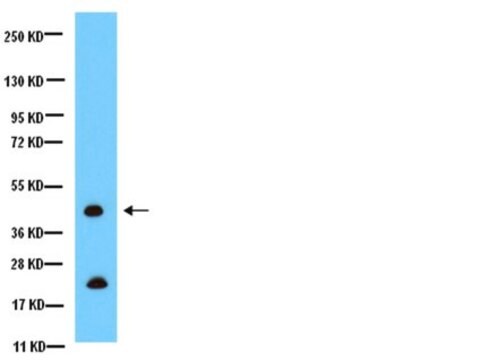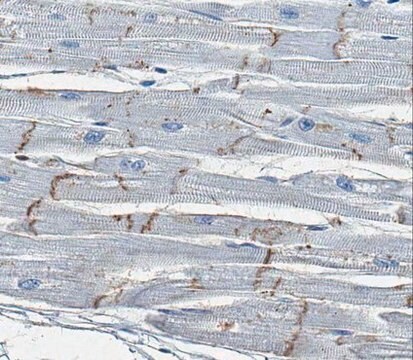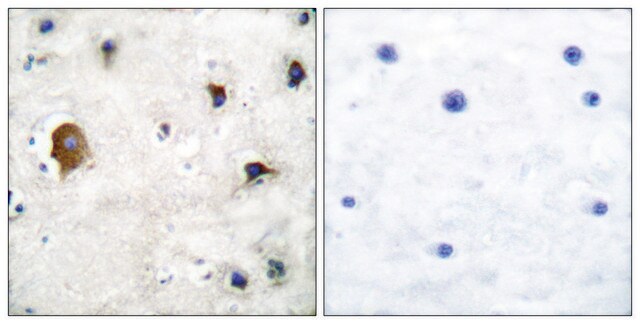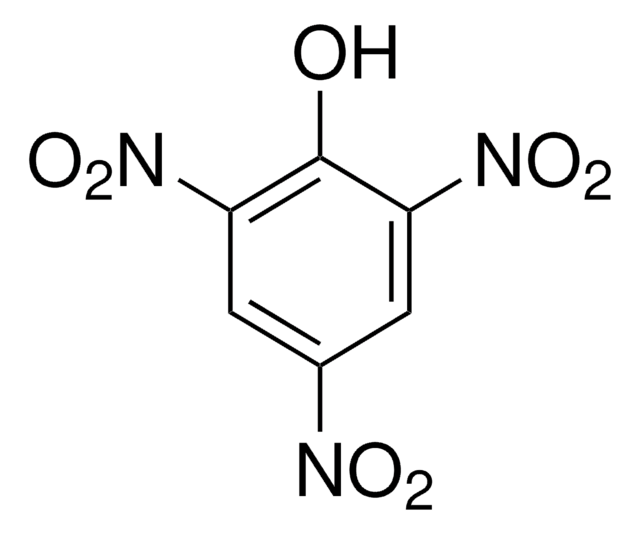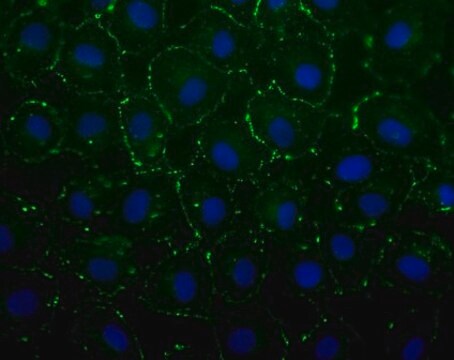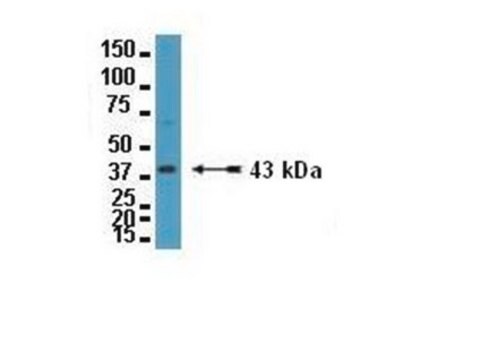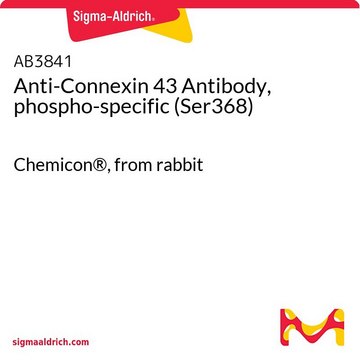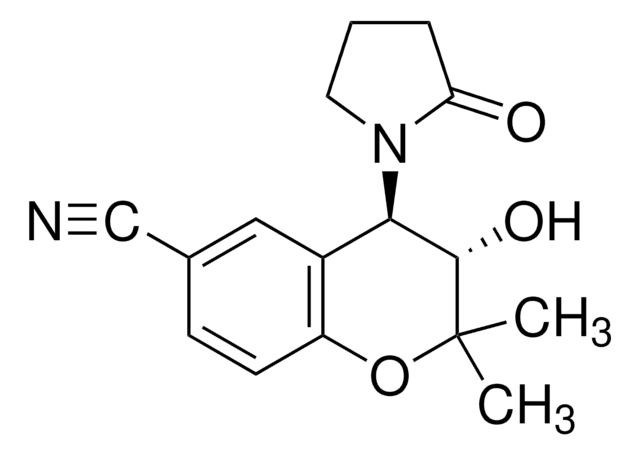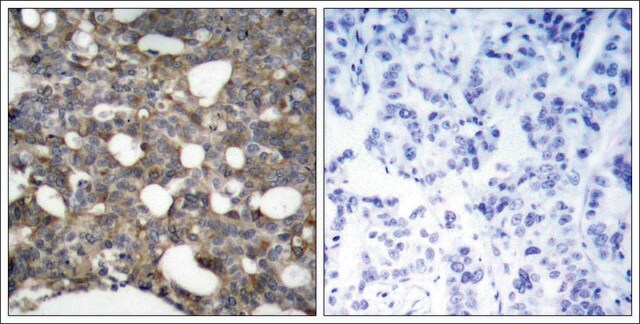C6219
Anti-Connexin 43 Antibody
rabbit polyclonal
Synonyme(s) :
Connexin 43 Antibody, Connexin 43 Antibody - Anti-Connexin-43 antibody produced in rabbit, Cx43 Antibody
About This Item
Produits recommandés
product name
Anti-Connexin-43 antibody produced in rabbit, affinity isolated antibody, buffered aqueous solution
Source biologique
rabbit
Niveau de qualité
Conjugué
unconjugated
Forme d'anticorps
affinity isolated antibody
Type de produit anticorps
primary antibodies
Clone
polyclonal
Forme
buffered aqueous solution
Espèces réactives
mammals, human
Conditionnement
antibody small pack of 25 μL
Technique(s)
immunocytochemistry: suitable
immunohistochemistry (formalin-fixed, paraffin-embedded sections): 1:2,000 using human or animal tissue sections
immunohistochemistry (frozen sections): 1:2,000 using human or animal tissue sections
indirect immunofluorescence: 1:400 using cultured BHK cells
microarray: suitable
western blot: 1:8,000 using an animal tissue extract
Numéro d'accès UniProt
Conditions d'expédition
dry ice
Température de stockage
−20°C
Modification post-traductionnelle de la cible
unmodified
Informations sur le gène
human ... GJA1(2697)
mouse ... Gja1(14609)
rat ... Gja1(24392)
Description générale
Gap junctions are specialized cell membrane domains consisting of aggregations of intercellular channels that directly connect the cytoplasm of adjacent cells. Gap junctions coordinate cellular and organ function in tissues and are involved in metabolic cooperation between cells, electrical coupling, synchronization of cellular physiological activities, growth control, and developmental regulation. The gap junction channels allow intercellular exchange of ions, nucleotides and small molecules between adjacent cells. Unlike other membrane channels, intercellular channels span two opposed plasma membranes and require the contribution of hemi-channels, called connexons, from both participating cells. These channels are permeable to molecules as large as 1 kDa, and they have been reported in most mammalian cell types. Two connexons interact in the extracellular space to form the complete intercellular channel. Each connexon is composed of six similar or identical proteins, which have been termed connexins. Connexins (Cx) are a multi-gene family of highly related proteins with molecular weights ranging from 26 to 70 kDa. At least a dozen distinct connexin genes have been identified in mammals, many expressed in a diverse tissue and cell specific pattern. Two distinct lineages have been identified in mammals, one termed class I or β group, in which Cx26, Cx30, Cx31, Cx31.1 and Cx32 fall, and the other termed class II or α group, represented by Cx33, Cx37, Cx40, Cx43 and Cx46.
Connexin-43 (Cx-43), a 43kDa protein, is a member of the connexin protein family that forms a gap junction. It is expressed by a variety of cell types, such as astrocytes, cardiac and smooth muscle, endothelium, ependyma, fibroblasts, keratinocytes, lens and corneal epithelium. In addition, the protein is also found in leptomeninges, leucocytes, Leydig cells, macrophages, myoepithelial cells of mammary gland, osteocytes, ovarian granulosa, pancreatic β-cells, preimplantation blastocyst, sertoli cells, thyroid follicular cells and trophoblast giant cells.
Spécificité
Immunogène
Application
A minimum working dilution of 1:8,000 is determined by immunoblotting using a whole extract from mouse brain.
A minimum working dilution of 1:400 is determined by indirect immunofluorescent staining of acetone-fixed cultured baby hamster kidney (BHK).
A minimum working dilution of 1:2,000 is determined by indirect immunofluorescent staining of rat heart. (Negative on rat liver sections)
A minimum working dilution of 1:2,000 is determined by indirect immunoperoxidase staining of trypsin-digested,formalin-fixed, paraffin-embedded human or animal tissue.
Actions biochimiques/physiologiques
Forme physique
Stockage et stabilité
Clause de non-responsabilité
Vous ne trouvez pas le bon produit ?
Essayez notre Outil de sélection de produits.
En option
Code de la classe de stockage
12 - Non Combustible Liquids
Classe de danger pour l'eau (WGK)
nwg
Point d'éclair (°F)
Not applicable
Point d'éclair (°C)
Not applicable
Certificats d'analyse (COA)
Recherchez un Certificats d'analyse (COA) en saisissant le numéro de lot du produit. Les numéros de lot figurent sur l'étiquette du produit après les mots "Lot" ou "Batch".
Déjà en possession de ce produit ?
Retrouvez la documentation relative aux produits que vous avez récemment achetés dans la Bibliothèque de documents.
Les clients ont également consulté
Notre équipe de scientifiques dispose d'une expérience dans tous les secteurs de la recherche, notamment en sciences de la vie, science des matériaux, synthèse chimique, chromatographie, analyse et dans de nombreux autres domaines..
Contacter notre Service technique

